It’s hard to imagine a cycling accessory that is more essential, affordable, or portable than the bike multi-tool. Mechanical issues happen, and being prepared can mean the difference between a quick, easy adjustment in the middle of a ride or ending up stranded in the middle of nowhere.
Whether you ride road, gravel, mountain bikes, or all of the above, carrying a quality multi-tool is an absolute necessity. When you need to tighten a loose bolt, make a mid-ride adjustment, or fix a broken chain, a good multi-tool is a critical accessory to have when you’re miles from home or the trailhead. And, if you don’t have a full set of bike tools at home, they can be handy for use there as well.
Having owned a variety of multi-tools over the years, losing and finding a few (remember to zip up those saddlebags, people), and trying a wide range of the latest models, we gathered 12 of the best multi-tools on the market to test and compare. Each model was tested by a member of the testing team for several months and sometimes years to help you find the perfect one to match your style of riding and bike repair know-how.
Our top bike multi-tool recommendations are listed below, followed by the best of the rest, which are great options that we feel are also worthy of consideration. Our Comparison Chart shows all the models we tested and their specs at a glance, and we provide helpful information in our Buying Advice and Price & Value section if you need help deciding what you need.
Editor’s Note: This guide was updated on November 12, 2024, with the addition of a Price & Value summary to help explain what you get for your money.
Best of the Rest
-
Removable ball-end hex wrenches -
Chain tool with assembly hook -
Disc brake pad spreader -
Sharp knife
-
No Phillips head screwdriver -
Limited Torx sizes -
A little heavier than some
-
Reversing ratchet -
Access into tight spaces -
Tire levers -
Patch/cash pocket -
Replaceable bits
-
No flathead screwdriver -
Separate bits -
Bigger size
-
Lightweight -
Small size -
Covers the basics -
Includes plugs and plugger
-
No flathead screwdriver or 8mm hex -
Compact size limits leverage
Comparison Chart
| Multi-Tool Model | MSRP | Measured Weight | # of Functions | Hex Keys | Torx | Screwdrivers | Chain Tool | Tubeless Repair Tools |
|---|---|---|---|---|---|---|---|---|
| Silca Italian Army Knife – Venti | $55 | 177g | 20 | 2, 2.5, 3, 4, 5, 6, 8 | T8, T10, T20, T25 | Phillips #2, flathead | Yes | No |
| Pro Bike Tool 20-in-1 | $27 | 118g | 20 | 2, 2.5, 3, 4, 5, 6, 8 | T25, T30 | Phillips, flathead | Yes | No |
| ToPeak Mini PT30 | $59 | 171g | 30 | 2, 2.5, 3, 4, 5, 6, 8, 10 | T10, T15, T25 | Phillips #2, flathead | Yes | Yes |
| Blackburn Switch Wrap | $50 | 176g | 16 | 2.5, 3, 4, 5, 6, 8 | T25, T30 | flat head | Yes | No |
| Crankbrothers M19 | $37 | 175g (215g w/ case) | 19 | 2, 2.5, 3, 4, 5, 6, 8 | T10, T25 | Phillips #1 and #2, flathead | Yes | No (M20 comes with) |
| Cannondale 18-in-1 w/ Dynaplug | $80 | 125g | 18 | 2, 2.5, 3, 4, 5, 6, 8 | T25 | Phillips #2, flathead | Yes | Yes |
| Wolf Tooth 8-Bit Kit Two | $140 | 172g | 26 | 2, 2.5, 3, 4, 5, 6, 8 | T10, T25 | Phillips #2, flathead | Yes | Yes |
| Unior Multitool Euro17 | $50 | 175g | 17 | 2, 2.5, 3, 4, 5, 6, 8 | T10, T25 | Phillips #1, flathead | Yes | No |
| Blackburn Wayside | $40 | 195g | 19 | 2, 2.5, 3, 4, 5, 6, 8 | T25, T30 | flat head | Yes | No |
| ToPeak Ratchet Rocket Lite DX+ | $53 | 195g | 20 | 2, 2.5, 3, 4, 5, 6, 8 | T10, T15, T25 | Phillips | Yes | No |
| Lezyne SV Pro-17 | $50 | 119g | 17 | 2, 3, 4, 5, 6 | T10, T25 | Phillips | Yes | Yes |
| Bontrager Pro Multi-Tool | $52 | 162g | 15 | 2, 2.5, 3, 4, 5, 6, 8 | T25 | Phillips, flat head | Yes | No |
Our bike experts know that having a good multi-tool can make the difference between continuing your ride or cutting it short, so we always carry one with us no matter where we’re going or what type of bike we’re riding. We can’t even count the number of times our multi-tools have been used over the years for everything from simple comfort adjustments, fixing chains, or tightening bolts that mysteriously came loose during a ride. And, we’re always seeking the best tool for the job, whether that’s a super lightweight option for races or a more comprehensive model for heading way off the grid on overnight adventures. Thankfully, we get to try out a lot of different multi-tools, so we can share our experience with you.
Our Expert Testers
For our bike multi-tools buyer’s guide, review authors Jim Graham and Jeremy Benson personally tested each of the 12 models included. Jim is an avid gravel rider who spends lots of time exploring the backroads of New England and knows the importance of having the right multi-tool while riding through remote forests on rough roads. He’s been cycling for many years and has used many different multi-tools in that time. He’s semi-retired from a career in journalism, but he’s keeping himself busy testing and reviewing gear and taking on freelance writing projects.
GearJunkie Editor Jeremy Benson has been professionally testing and reviewing bike gear for over eight years. He’s a gravel and mountain bike racer who spends an inordinate amount of time on the bike testing products, training, and riding for fun. In addition to testing over 30 multi-tools in the past few years, he’s constantly making mid-ride adjustments while testing everything from complete bikes, pedals, and shoes, and has come to appreciate the quality multi-tools that help to make his life easier. Jeremy has also provided his expertise in testing and reviewing the best hitch bike racks, protective mountain bike helmets, and our favorite mountain bike shoes.
Our Testing Process
After researching the best bike multi-tools on the market, we rounded up a diverse selection of 12 models for side-by-side testing and comparison. Each tool was weighed for consistency and comparison to manufacturers’ specs and examined to check the design and build quality. We shoved each multi-tool into jersey pockets, saddle bags, and fanny packs to analyze their portability and took them out on rides of varying lengths on the off chance we might need to use them in the field. We also ran each model through a series of tests in the home workshop to test their ergonomics, the functionality, and durability of all the tools, and to use features like chain tools, quick link storage, quick link tools, disc pad spreaders, and, of course, bottle openers. When testing concluded, we zeroed in on our favorites and those that excel in specific ways compared to the rest.
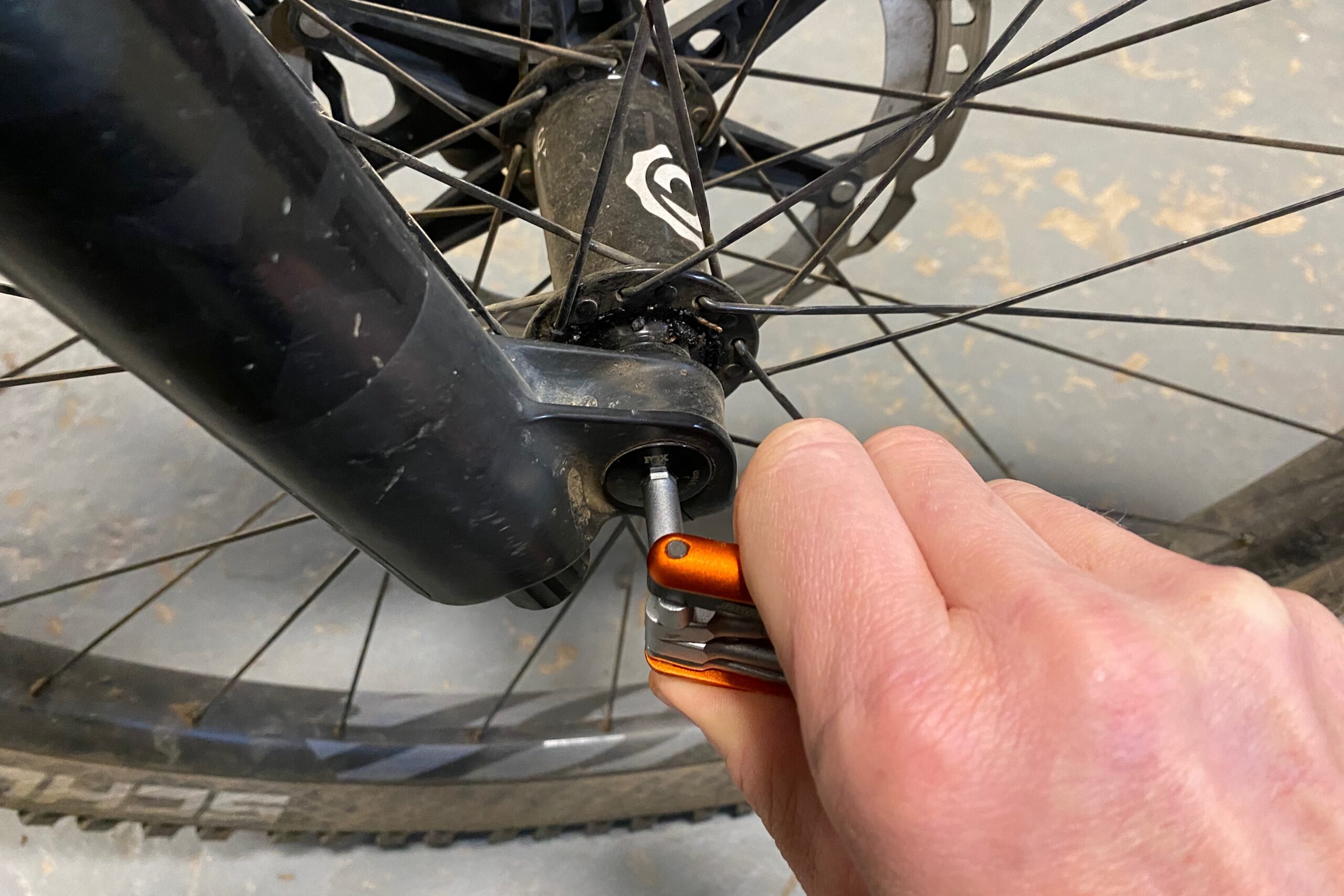
With so many multi-tools offering a dizzying array of functions and features, it’s easy to get lost while comparing all the specs. But answering this question will go miles toward simplifying your search: How will you actually use a multi-tool?
Almost every multi-tool we’ve ever tried will handle the most common, basic repairs and tweaks on a road, gravel, mountain, or e-bike – adjusting a saddle or handlebars or tightening a loose bolt. So, think about your bike mechanic skills before you buy. In addition to the basics, do you know how to adjust a derailleur? Re-center your disc brakes? Fix a broken chain? True a warped wheel?
Knowing how to use the tools is just as important as having them, so taking a bike maintenance or repair course could be a great way to learn new skills that may come in handy down the road or trail. There are also great tutorial videos you can find online to figure out how to fix certain things (Park Tool has great how-to videos).
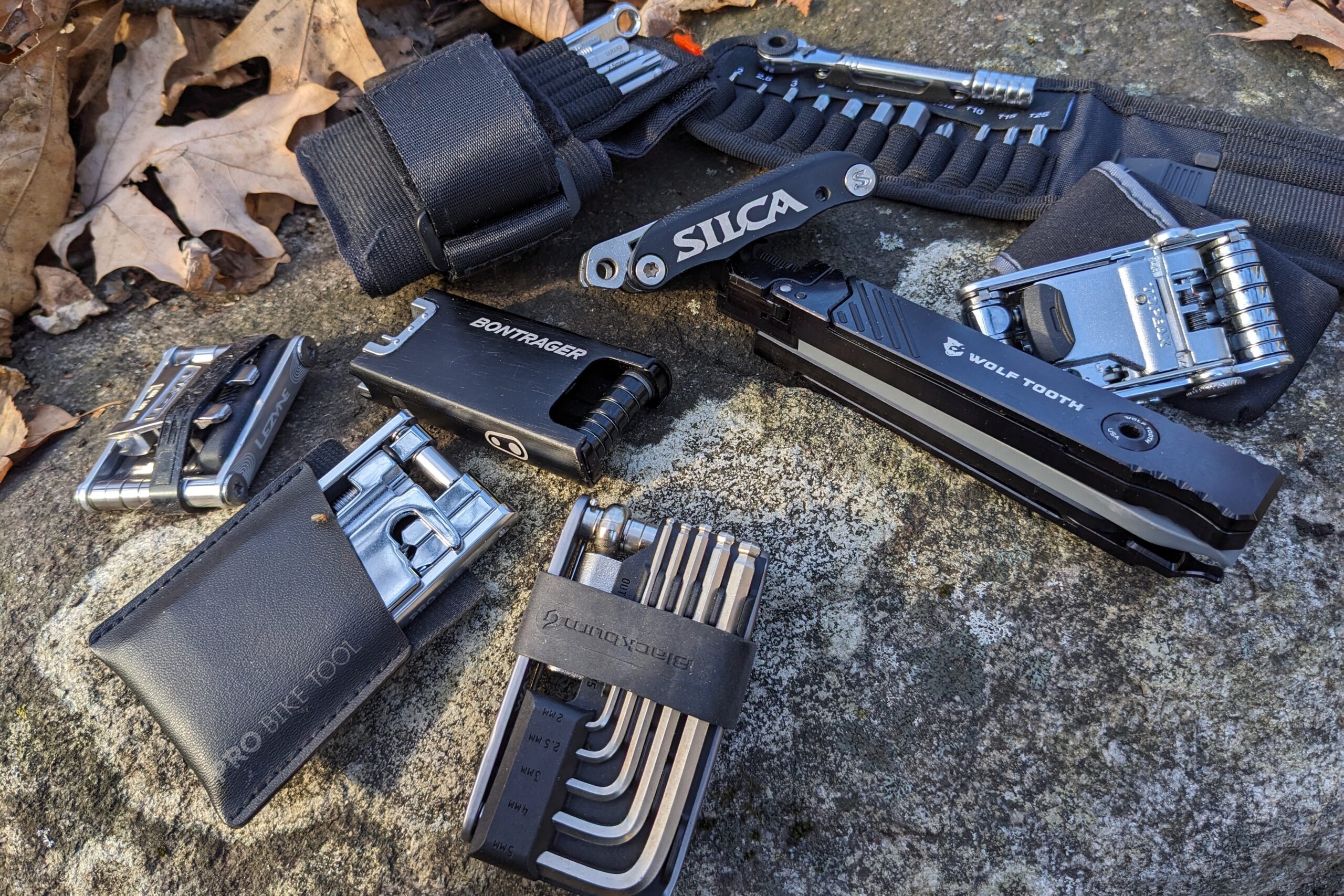
What Tools Do You Need?
Taking some time to familiarize yourself with your bike(s) and all the parts can give you a good idea of what tools you need to make adjustments out on a ride. It pays to know the specific hex sizes, Torx bits, and screw heads your pessoal bike requires. For instance, some derailleurs, such as the Shimano GRX, take a small, 2mm hex wrench – not included on some multi-tools – to adjust the limit screws. And, depending on the tools your bike needs, know that many brands make several versions with varying tools included, so you should be able to find one that suits your needs.
It may sound obvious, but your multi-tool should suit the adjustments and fixes you’re comfortable making. If you’ll use it only to make occasional, quick, and easy repairs during a ride, then look for these common features:
- Hex (aka Allen) wrenches in 2, 2.5, 3, 4, 5, 6, and 8mm
- A Phillips and/or flathead screwdriver
- Torx wrenches that fit your bike (the most common are T10 and T25)
- A chain tool (assuming you know how to use it)
The above selection of hex, Torx, and screwdrivers should be able to handle most of the simple adjustments and fixes that most well-maintained bikes will require on a ride. There’s a reason that every model in this review has a chain tool, and that is because it is pretty critical in the off chance you break a chain during a ride, but you have to know how to use it for it to be effective. While breaking your chain doesn’t happen that often, it does happen, and even if you carry a quick link (or master link) to rejoin your broken chain, the broken section of the chain almost always needs to be removed to install it. Again, watching an instructional video and/or practicing at home on an old chain can be the difference between making a fix in the field and continuing your ride, walking out of the woods, or calling your significant other for a roadside pickup. Of course, proper drivetrain maintenance and choosing the right chain lube can help prevent it from happening in the first place.
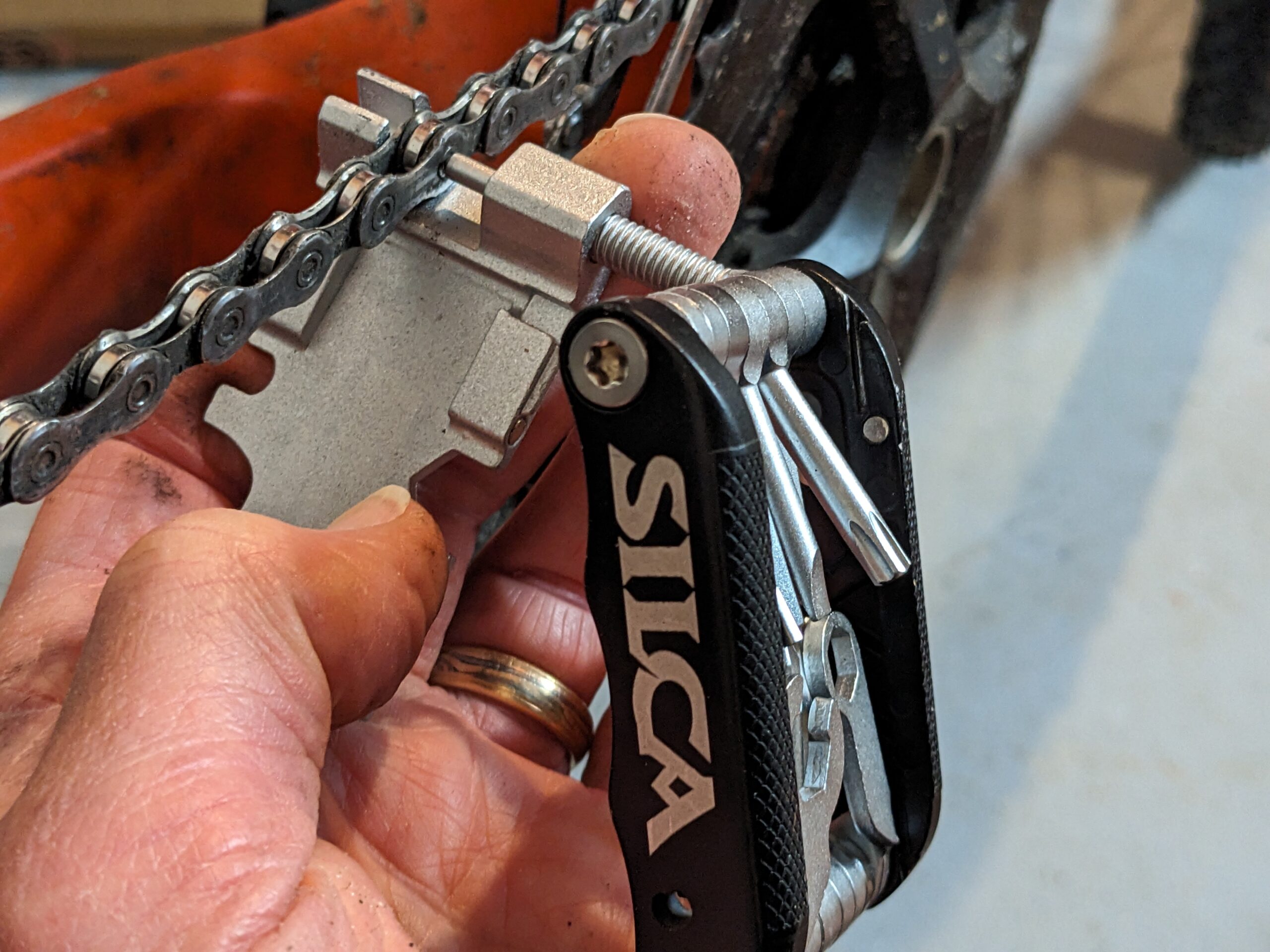
Depending on the duration of your rides or the remoteness of your adventures, additional tools may be helpful to keep you from having an epic bike breakdown many miles down a gravel road with no cell service. Lots of bike multi-tools include other functions than the essentials listed above, including things like quick-link storage, valve core tools, spoke wrenches, disc pad spreaders, disc rotor truing tools, knife blades, tubeless repair tools, plugs, and more. To be self-sufficient, it’s important to have the tools you need to keep your bike rolling. One of the most comprehensive tools we tested is the Wolf Tooth 8-Bit Kit Two, which would be our pick for extended bikepacking trips where you might not see people for days.

Tubeless Tire Repair
With the proliferation of tubeless tires across all types of cycling, carrying tubeless repair tools is necessary for many riders. While tubeless plug and plug tools have traditionally been something we carry independently of our multi-tools, many models are now coming with them integrated into their designs for an all-in-one tool and tubeless repair kit. Not every multi-tool comes with tubeless tools or plugs, of course, but many do, and some brands offer multiple models that come with or without to suit varying needs and preferences. These features often consist of a tubeless needle/plugger that can be used to push a “bacon strip” into a puncture and storage space for some tubeless plugs.
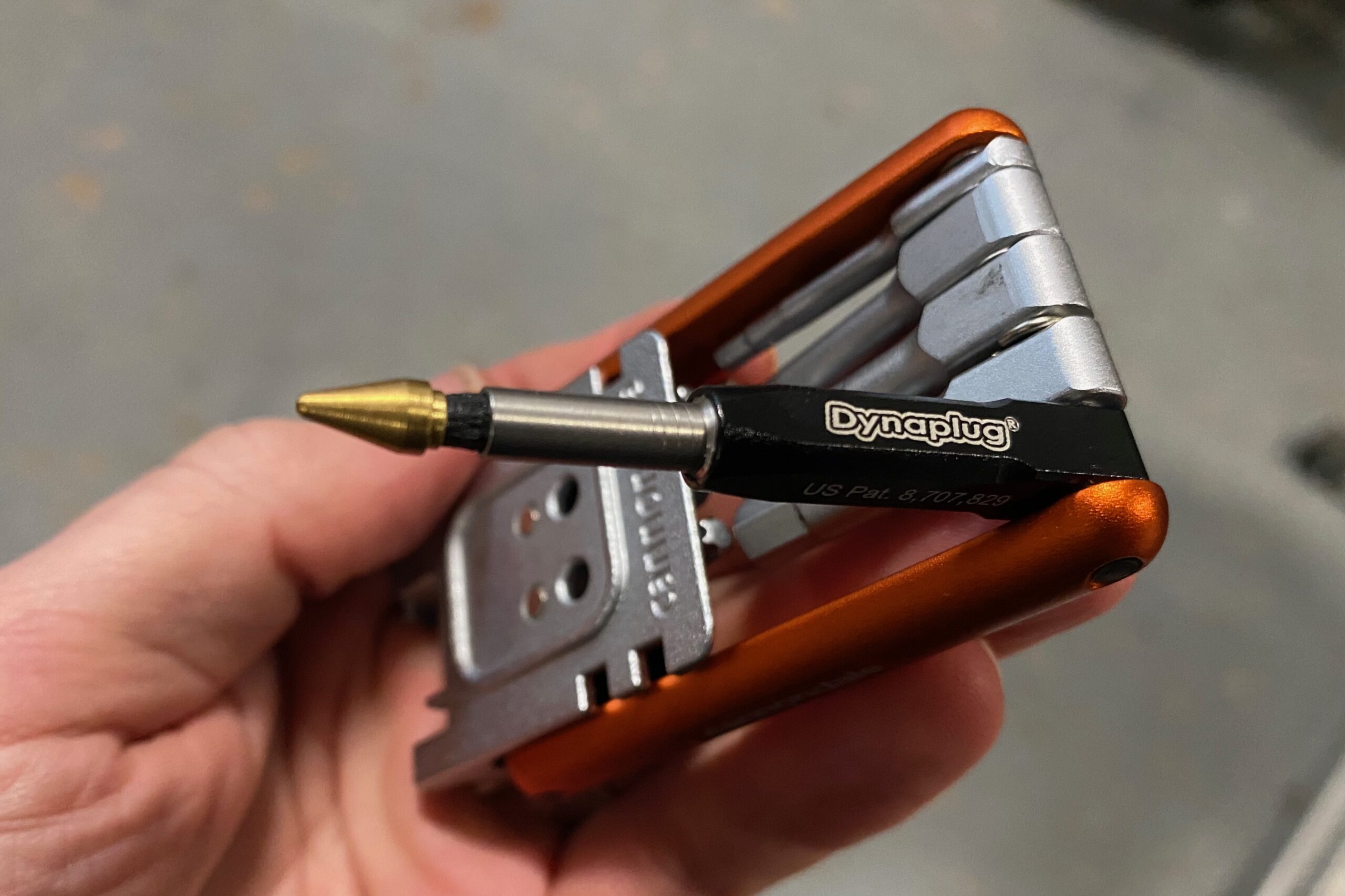
The models we tested that include tubeless repair tools are the ToPeak Mini PT30, the Lezyne SV Pro-17, Wolf Tooth 8-Bit Kit Two, and the Cannondale 18-in-1 with Dynaplug. The ToPeak, Lezyne, and Wolf Tooth all have plug insertion tools for “bacon strip” type plugs and the latter two models even come with some. The Cannondale tool comes with a dual-head Dynaplug tool and its easy-to-use pointed metal tip plugs. Plug preferences vary, of course, with some riders swearing by bacon strips and others preferring Dynaplug or other options.
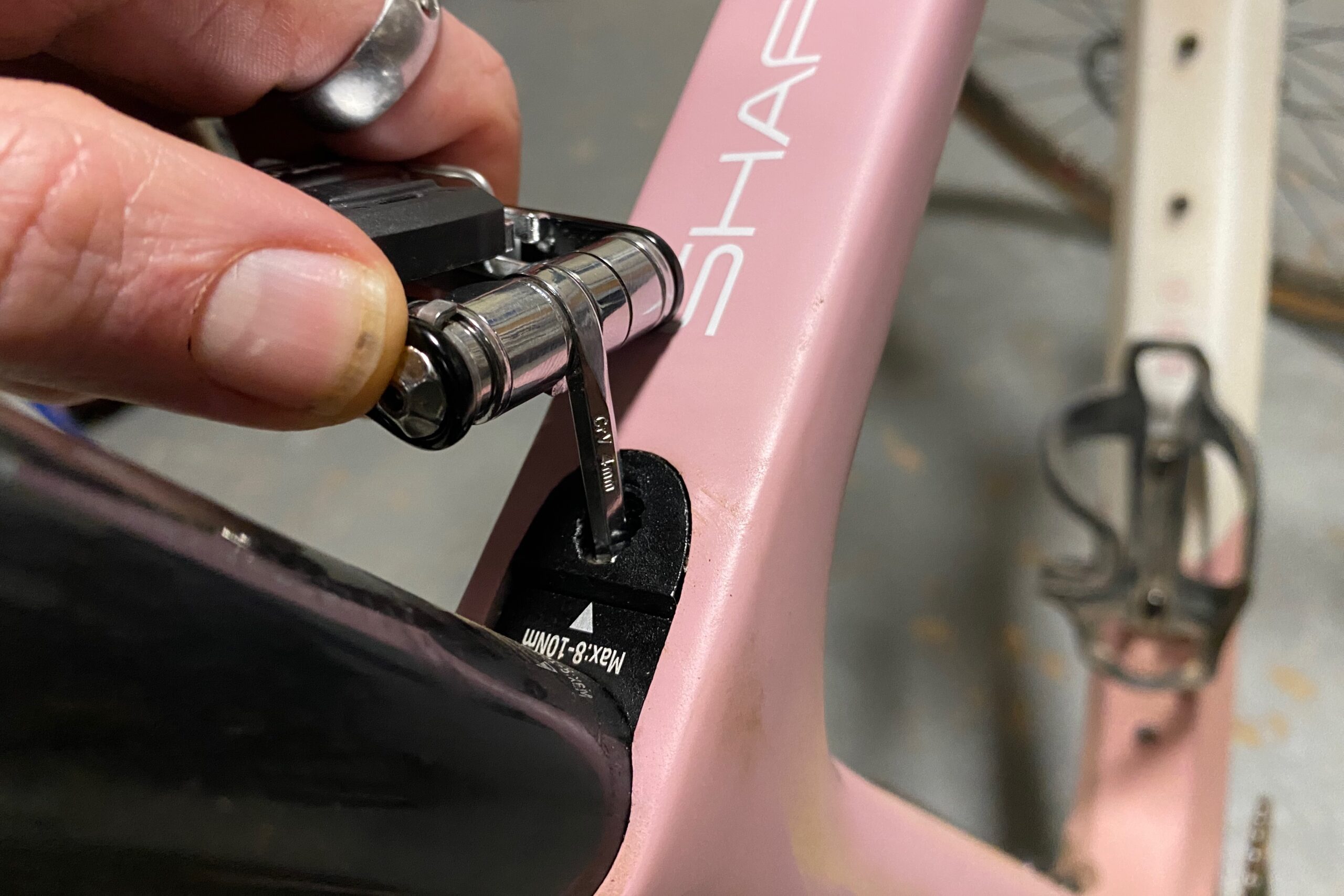
Ergonomics
Compared to regular workshop tools, most multi-tools sacrifice a bit in ergonomics for the compact form that they need to take to pack many tools into a portable and lightweight unit. This is particularly true of most folding tools that have short, folding bits and rectangular shapes. They typically feel pretty good in your hands and provide adequate torque for simple fixes or adjustments, but the length of the bits and the shape of the tool itself can often mean that accessing hard-to-reach bolts is awkward. Still, they can get the job done most of the time.
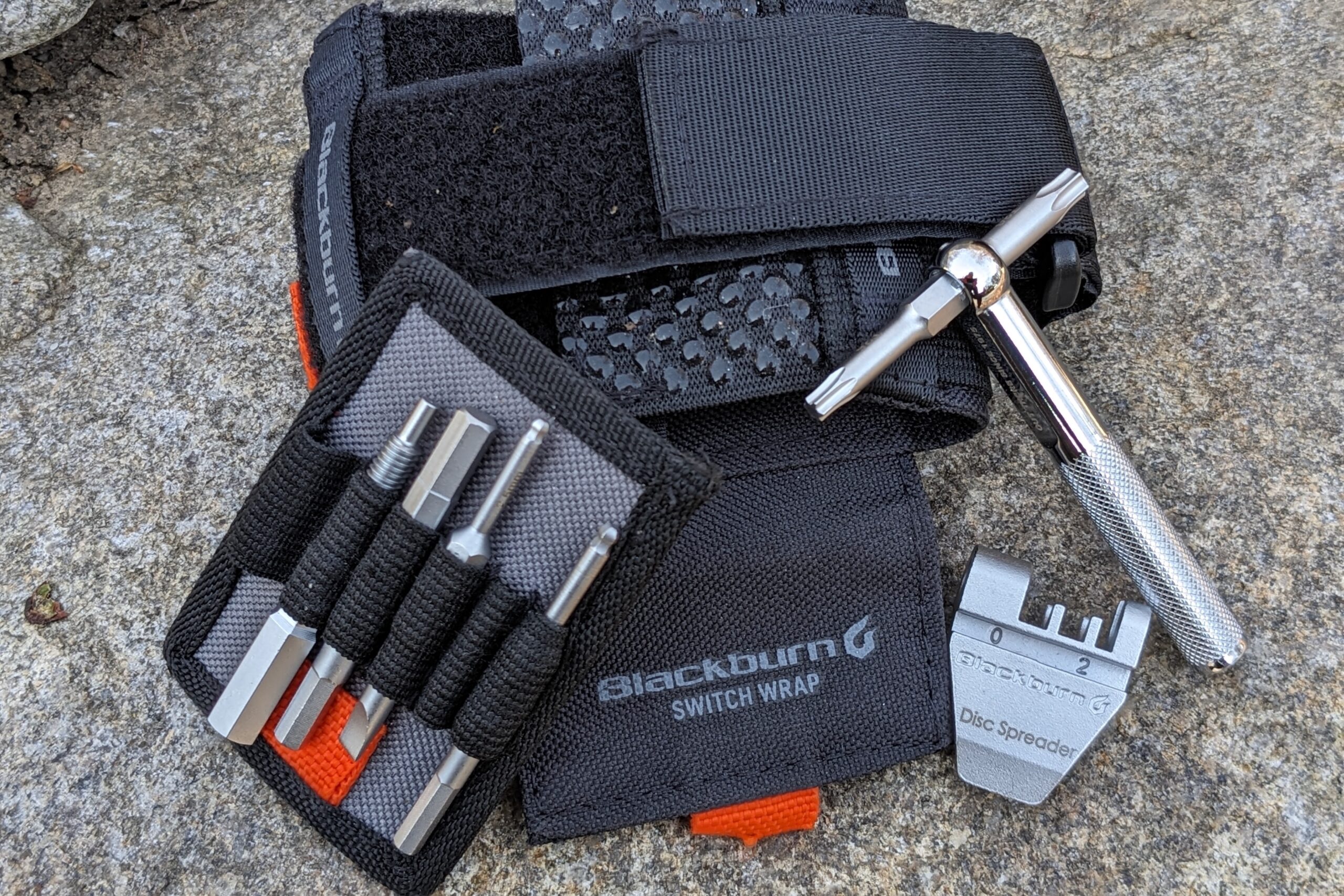
Some tools go out of their way to try and have ergonomics that mimic regular shop tools. The Blackburn Switch Wrap Tool Kit, for example, has a great handle that can extend the removable bits or be used straight on or in a T-shape. Similarly, the ToPeak Ratchet Rocket Lite DX+ not only has ratcheting capability but it can be used in multiple configurations to reach certain bolts. Also, the Wolf Tooth 8-Bit Kit Two has a swiveling head for its removable bits that can be used at various angles. Going a step further, the Blackburn Wayside has individual hex keys for sizes 2, 2.5, 3, 4, and 5mm, that make them super easy to use.
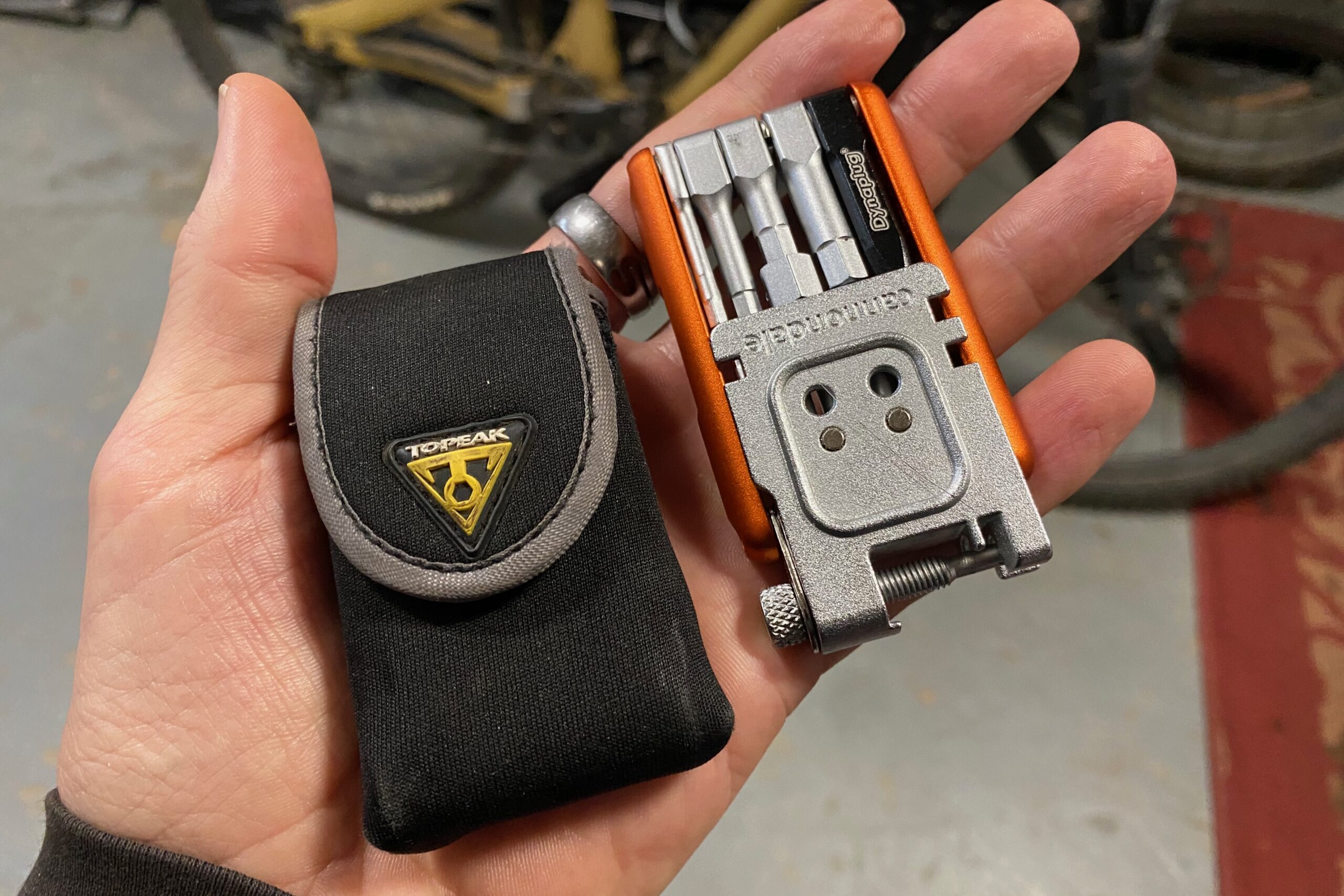
Portability: How Are You Going to Carry It?
A bike multi-tool only works if you have it with you, so it’s important to consider how you intend to carry it while riding when choosing the right one for your needs. Fortunately, they are typically relatively lightweight and compact, so most will be easy to stash in a jersey or missão bib pocket, saddle bag, hydration backpack, hip pack, bottle mount tool canister, or in-frame storage compartment. But, some are smaller and lighter than others, making them easier to squeeze into a small saddle bag or be less noticeable in your pocket. Some even have storage cases to keep them tidy and feeling pleasant against your lower back or keep them from snagging on other things in your pack.
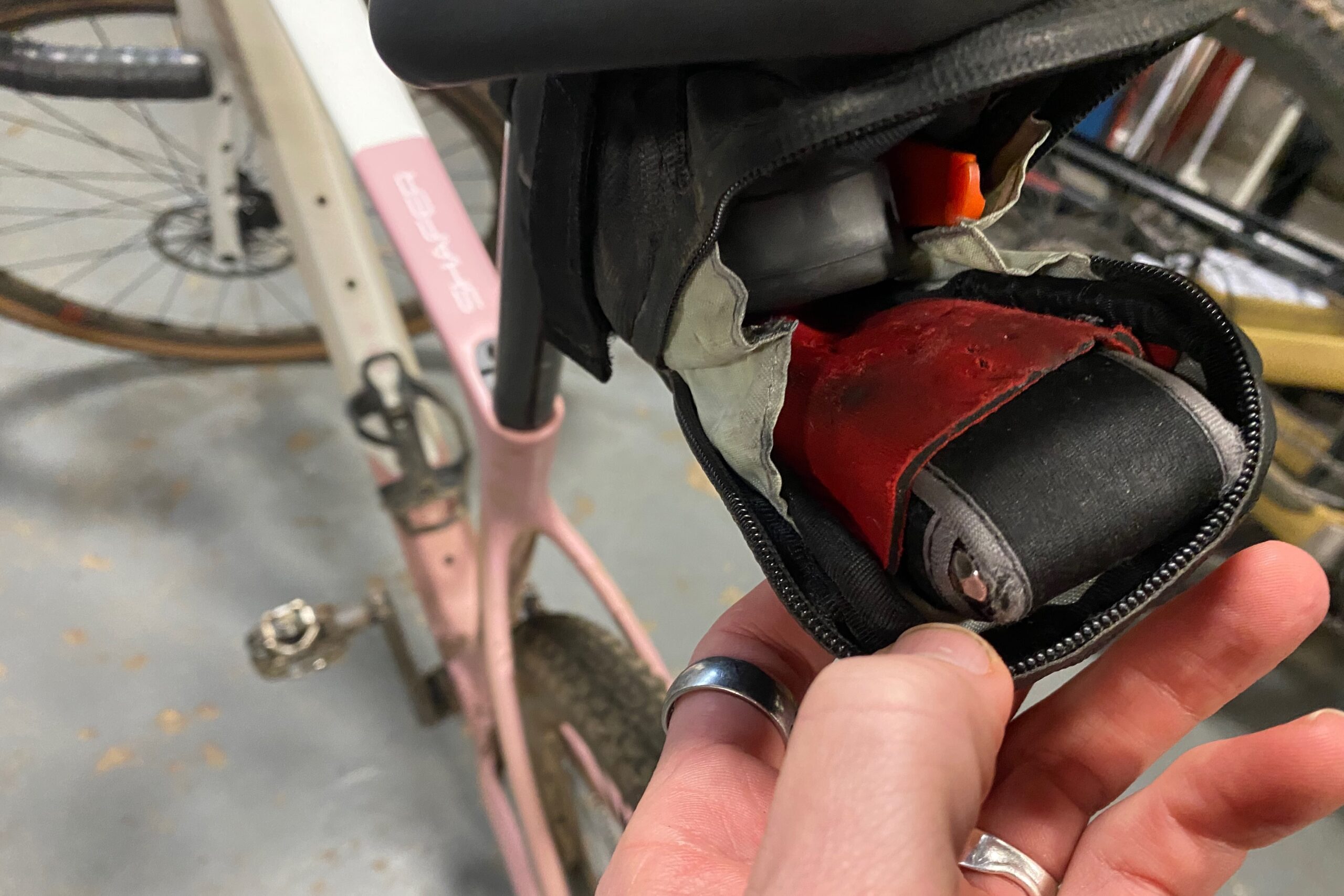
The differences in weight among the models we tested aren’t incredibly significant, with only about 80 grams separating the lightest, 118 grams, and the heaviest, 195 grams, though it is certainly notable and may make a difference to those who are particularly weight-conscious. Not surprisingly, however, the two lightest models we tested, the Pro Bike Tool 20-in-1 and the Lezyne SV Pro-17, also happen to be a couple of the slimmest and most compact, making them quite easy to fit into small spaces. Also, not surprisingly, a few of the heaviest models we tested, like the Blackburn Wayside and the Wolf Tooth 8-Bit Kit Two, are some of the largest. The added weight and size, however, is a tradeoff for extra or specialized tools and better ergonomics and leverage.
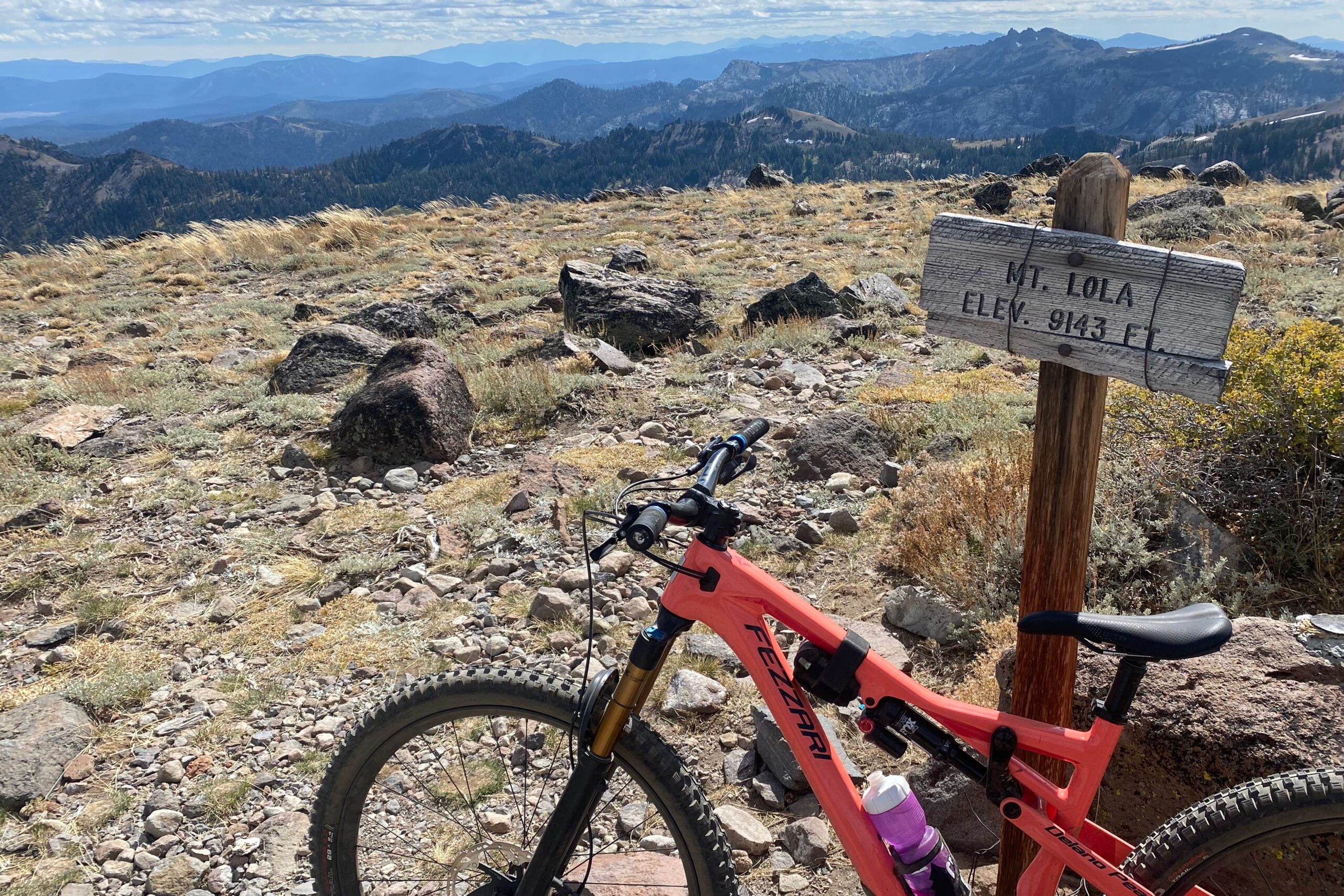
While there are many ways to store tools on bikes themselves these days, one of the best we’ve found is the Blackburn Switch Wrap Tool Kit. Not only does it include a solid tool selection, but the wrap can hold additional items like a tube, CO2 canisters, tire plugs, and tire levers and be strapped to your frame or saddle. This can help get weight off your body, eliminate the need for a saddle bag, and always ensure that you’ve got your repair kit ready and with you while you ride.
Other Things to Carry
We feel that a good multi-tool is an absolute necessity to bring with you on any type of bike ride, whether it’s road, gravel, mountain, or even a daily commute. It’s not the only thing you should bring with you, of course, as a multi-tool can only do so much. What else you should bring with you depends on what type of riding you’re doing and how far you’re going, and may also be specific to the bike you’re riding.
No matter the type of bike, we always recommend bringing a tube (that is the correct size for your tires) or possibly two if you’re prone to flatting, tire levers, and tubeless tire plugs (if you run tubeless). You’ll also want some way to inflate your tires, like a mini pump or CO2 canisters and a CO2 inflator. A quick link (that is the right size and brand to match your chain) can speed up chain repair, and zip ties and/or some duct tape can often come in handy, too. Of course, it’s always good to bring a first-aid kit for unexpected emergencies, possibly some toilet paper, some cash or a card, and, of course, snacks and water.
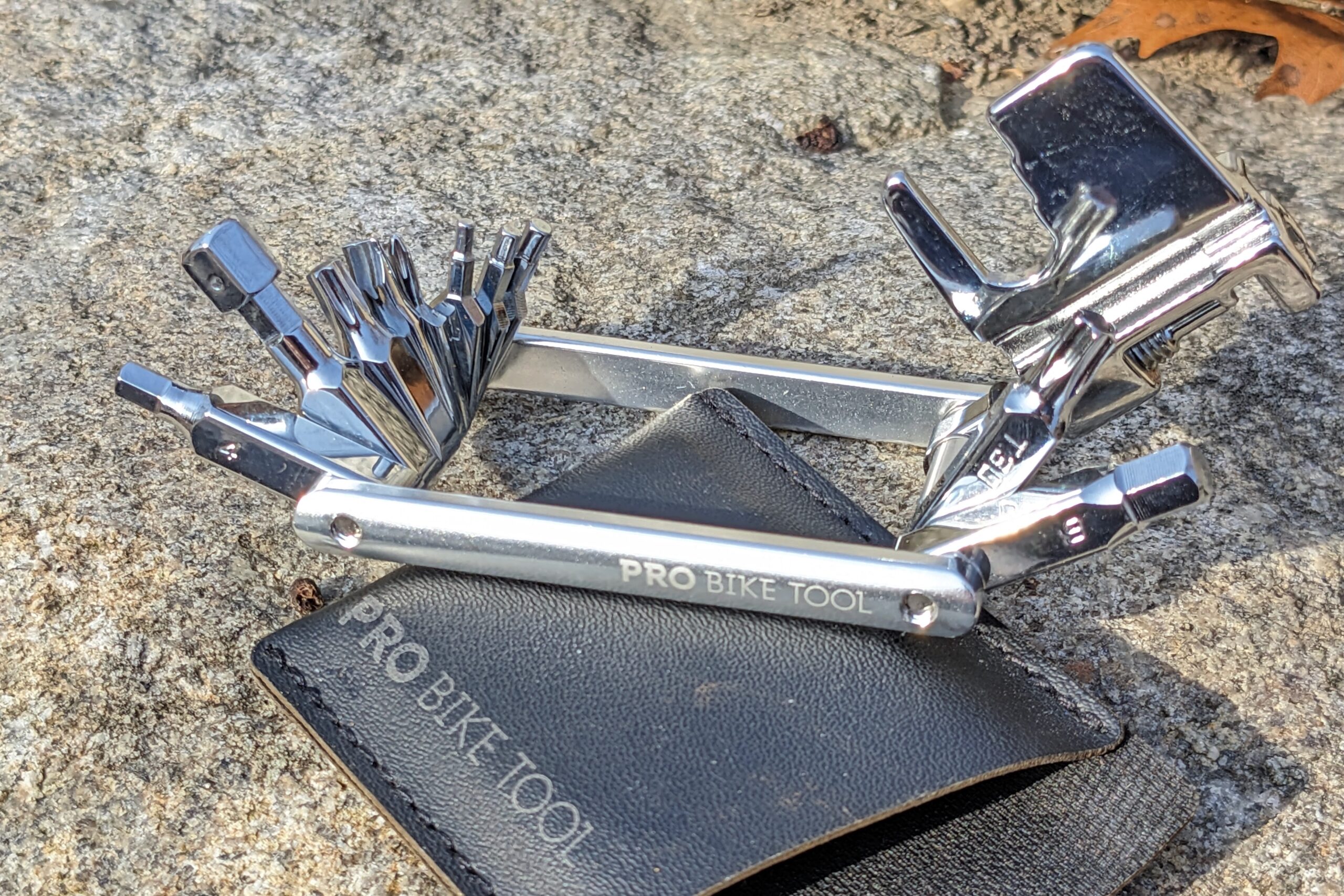
Price & Value
It’s hard to put a price on something as important as a bike multi-tool that can potentially save your rides and from frustration. Still, these things cost money, but when you have the tools to make quick fixes and adjustments on a ride, it’s money well spent. The models we tested range in price from $29 up to a whopping $140. In general, the more functions a tool has, the more it costs, but special features like tubeless repair or more complex designs often add to the price, too.
How much you’re willing to spend depends on your budget, of course, but know that even the least expensive option is probably going to have you covered 99% of the time. It’s also important to note that multi-tools typically last for many years when treated with a reasonable amount of care, making even the more expensive options a good value over time. A great example is the Crankbrothers M-series tools, which can last quite literally for decades.
Budget
Being prepared on a ride doesn’t have to cost a lot of money. In fact, there are plenty of budget-friendly bike multi-tools on the market that will set you back less than $20. Having tested quite a few over the years, we’ve learned that these are typically fairly basic and made from lower-quality materials, but they’ll get the job done even if they aren’t the most durable. We’ve learned that spending just a little more is usually worth it for a higher quality and longer-lasting tool.
For this reason, the Pro Bike Tool 20-in-1 ($27) is our top recommendation in the budget price tier. This tool is lightweight, compact, well-made, and packed with 20 functions. It’ll get you out of most trailside or roadside jams, and it will last several years longer than the cheap no-name options.
Mid-Tier
If you look at the comparison chart above, you’ll see that nearly all of the other tools we tested fall in the $40 to $60 range. While the number of functions varies between models, all of these tools are fully featured and made from tough, corrosion-resistant materials. Some include tubeless repair tools, others have nifty carrying cases, and some lean more toward specialization or ergonomics.
The Silca Italian Army Knife – Venti ($55) is a great example. Silca is a brand renowned for the performance and durability of its bike pumps and has carried that quality over to its multi-tools. With 20 functions, excellent ergonomics, and a quality construction, this is one the best we’ve ever used. ToPeak’s Mini PT30 ($59) commands a higher price for packing 30 (mostly) useful functions into a tiny package that fits in the palm of your hand. It also comes in a neoprene storage pouch to keep things tidy or comfortable in your jersey pocket.
Another interesting option in the mid-tier price range is the Blackburn Switch Wrap ($50). While it isn’t the quickest to deploy, the ergonomics of the tools are excellent, and we love the fact that it provides an on-bike carry solution for other necessities like a tube, CO2, and tire levers to keep weight off your body.
Premium
When you climb above the $60 mark, we enter premium bike multi-tool territory. We only tested a couple of models in this price range, one of which is the Cannondale 18-in-1 with Dynaplug ($80). While the tool itself is a relatively standard folding affair, it also includes an integrated Dynaplug tubeless plug tool. Given that standalone Dynaplug pluggers cost around $60, it makes sense that it costs $80 when attached to an 18-function multi-tool.
The Wolf Tooth 8-Bit Kit Two ($140) is essentially comprised of 3 separate tools in one. Each part of this 3-piece kit has several related functions and can be carried on its own or grouped together for the ultimate bike multi-tool. This tool is exquisitely machined, with magnets holding everything together. If you like to be super prepared or maybe you’re heading out on a week-long bikepacking trip, a comprehensive tool like this can potentially save you the trouble of carrying a separate multi-tool, which can save space and weight.
Frequently Asked Questions
Do you own a bike? Then yes, absolutely! We feel that a bike multi-tool is a must-have for any ride. Whether you need to make a comfort adjustment, tighten a loose bolt, adjust a derailleur, fix a broken chain, or any other variety of things, a good multi-tool should be able to get you back rolling instead of doing the walk of shame. If you don’t have a set of tools at home, a good multi-tool could also be super helpful for doing simple maintenance and repairs on your bike around the house. Either way, the answer is yes, we don’t ride without one and you shouldn’t either.
Determining which tools are most important to have with you can help you narrow down the choices to find the right multi-tool. Assessing which hex, Torx, and screwdriver sizes your bike requires is a good first step, along with weighing the usefulness of other features like chain tools, tubeless repair, quick link storage, etc. It’s also important to consider how you intend to carry the tool as that may steer you in the direction of smaller and lighter options. The duration of your rides and/or the distance you’re traveling from civilization may also be a factor that sways you towards something more basic for shorter rides or something comprehensive to keep you rolling when you haven’t seen a person or had cell service for several hours.
In an ideal world, you’d have a multi-tool for mid-ride adjustments that lives in your saddle bag or riding kit year-round — one that you won’t take out to work on your bike in your home shop and then, inevitably, forget to put back in your saddlebag before your next ride. (We’ve all done it). You’d also have a selection of high-quality shop tools for every need in your bike workshop. But who lives in an ideal world?
Over many years of riding, however, we’ve found that it really does pay to have a separate multi-tool for each bike you own, kept in its own saddle bag or kit. This will save you time trying to find a multi-tool before a ride, and it will also allow you to match each multi-tool to the specific bike. On our road bikes, for instance, we keep a lightweight, compact tool with just the basics. For longer gravel and bikepacking rides, we pack a tool with a wider range of functions, along with tubeless tools and plugs, tire levers, and valve core tools and plugs.
It’s also nice to keep a sturdy, multi-tool in your home shop. They’re great for when you want to make quick adjustments and don’t want to fish around in your shop toolbox. It’s also nice if the multi-tool in your shop includes a bottle opener.
In our experience, broken chains don’t happen all that often, but you’re pretty much out of luck if it does break and you don’t have a tool to fix it (or know how to use that tool). It tends to happen more often in mountain and gravel biking when the chain is frequently under heavy loads and ridden in dirty conditions. But even then, if your chain is maintained, it’s possible to go a few years without breaking a link. Still, there’s pretty much no way to fix a broken chain without a chain tool, even if you’re carrying a quick link. That’s why all of the tools in this review have chain tools; because you’re much better off having one and not needing it than the other way around.
Also, keep in mind that it takes some know-how and experience to fix a broken chain with a chain tool. It is much easier if you have a quick/master link, but even then it takes some know-how to do it right. We’ve seen a few riders on the side of the trail with a broken chain, holding a multi-tool with a chain breaker, and not knowing how to use it. (Be a good fellow cyclist and offer to help these folks.) It’s a skill that can be tricky to master, so it helps to practice on an old chain at home first. Note: If you plan to use a quick/master link, make sure it matches the number of speeds on your bike, usually 10, 11, or 12 speeds, which require links specific to each chain.
Nothing really at all. They are two names for the same thing. The term “Allen” comes from the Allen company that produced tools with hex-shaped heads and those tools became colloquially known as Allen wrenches. These days, the terms are used interchangeably to refer to the keys/wrenches with sextavado heads and are measured in millimeter sizes. Bolts with hex heads are the most common on all types of bikes, so they are among the most important tools on a multi-tool.
Some tools include an array of separate bits that must be inserted into a handle to use. The advantage is that these generally make it easier to access tight spaces because the handles can be configured to hold the bits at different angles. The individual bits are also easily replaceable and can be found in most hardware stores, so you can carry spare bits or a wider selection of bits. The disadvantage is that the small bits are easy to drop and lose, especially in the dirt and poor lighting conditions – and black-colored ones seem to have a talent for disappearing in leafy duff.
Multi-tools with fixed bits hold all the tools together in one neat package, so selecting the right tool is like opening a blade on a Swiss Army Knife. They’re extremely easy to use, and they are much faster to work with in the middle of a ride than multi-tools with separate bits. The downside is that some models, especially those with short bits, can make it tougher to access tight spaces.
In our opinion, size, though it depends on your specific needs. A compact multi-tool will leave more room in your saddle bag, fanny pack, or jersey pocket for other things, like a spare tube, tire levers, or an extra snack. The shape is also somewhat important because you want a tool that feels comfortable in your hand or a back pocket, is easy to grip, and provides good leverage.
The difference between the heaviest and lightest multi-tools we reviewed is less than 80 grams (a little over 2 ounces). That’s not enough to sway our buying choice, though the very weight-conscious riders among us may prioritize low weight over all else.
Finally, price. Trust us on this: A good multi-tool will pay for itself the first time it saves you from being stranded, and is a wise investment that will last many years.
Multi-tools are pretty simple things, and they really don’t require much attention. Given that they are made from metal, however, it’s best to try and keep them relatively dry if possible to prevent the bits from corroding over time. Even tools that have corrosion-resistant coatings can start to corrode if they stay damp enough for long enough. If you know your tool has gotten wet, it is good practice to take it out of your saddle bag or pack to let it dry out — just don’t forget to put it back before your next ride.
Also, some folding multi-tools can get loose over time, and the tools can fold out too easily, sometimes flopping around while you try to use them. This can usually be remedied by snugging up the bolt that holds the side plates together (the piece from which the tools pivot).
Lastly, taking a little care while using the tool can help to prevent stripping both the tool heads and the heads of bolts.

